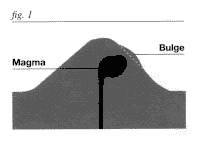 |


|
Lesson 2 Activity 1: The Mountain Blows its Top
- 45 minutes
- By observing two demonstrations, students will understand
(1) why a bulge developed on the north flank of Mount St. Helens and
(2) why the avalanche triggered an explosive eruption.
Key teaching points
- The bulge that developed on the north flank of Mount St. Helens was evidence of changes occurring inside the volcano. Magma was moving closer to the surface and inflating, or deforming, the side of the volcano.
- Scientists had been closely monitoring the growth of the bulge for nearly a month to help them try to forecast an eruption.
- The 5.1 magnitude earthquake on May 18, 1980, shook the volcano, including the bulge area. In turn, the shaking of the bulge area caused a sudden collapse of the volcano's north flank and triggered a large avalanche.
- The removal of this large mass of rock by the avalanche caused a sudden release of pressure inside the volcano and a violent eruption occurred.
Materials
- 1,500 ml beaker (PyrexTM)
- Damp sand
- Several small balloons
- Rubber bands
- Bunsen burner or hot plate
- Straight pin
- A bottle of soda water
- Basin or bowl to catch the "explosion"
- Master Sheet 2.1
Procedures
Preparation
Before class begins, put about ½ inch of sand in the bottom of the beaker and level the surface of the sand. Partially inflate a balloon, secure it with a rubber band, and place the balloon on top of the sand in the beaker. Cover the balloon with sand to a depth of about 1 ½ inches. Level the surface of the sand.
Introduction
 In class begin the lesson by reviewing the series of events that occurred on May 18, 1980. Use Master Sheet 2.1 to discuss the following events: the bulge that had been growing on the north side of the volcano for a month, the 5.1 magnitude earthquake that triggered an avalanche, and the avalanche that unleashed an explosive eruption, a lateral blast.
In class begin the lesson by reviewing the series of events that occurred on May 18, 1980. Use Master Sheet 2.1 to discuss the following events: the bulge that had been growing on the north side of the volcano for a month, the 5.1 magnitude earthquake that triggered an avalanche, and the avalanche that unleashed an explosive eruption, a lateral blast.
Demonstrations
Demonstration 1: Why the bulge grew
 |
- Partially inflate a balloon. Ask students what would happen to the balloon if you were to heat the air in the balloon? (The balloon would expand because the air expanded.) Explain that inflation caused a bulge to develop on the north flank (side) of Mount St. Helens.
- Tell the students that the inflated balloon represents the magma rising within Mount St. Helens and that the sand represents the surface of Mount St. Helens. (fig. 1)
- Show the beaker to the students and tell them you have a partially inflated balloon in the beaker. Place the beaker on the Bunsen burner or the hot plate. Heat the beaker until the balloon begins to expand. (The surface of the sand should begin to "bulge".) (fig. 2)
- Observe the changes in the shape of the surface of the sand. What happens to the "land" as the "magma chamber" expands?
|
Demonstration 2: Why the avalanche triggered the explosive eruption
- Ask students what would happen if you were to stick a pin into the balloon. (It would pop or explode.) Why does it explode? Burst the balloon. (The balloon bursts because the pressure inside the balloon is suddenly released and the gases can escape rapidly.)
- Ask students what happens when they open a bottle of soda. (It goes "fizz" because the gas, CO2, in the soda escapes.) Demonstrate this by shaking a bottle of soda water and releasing the cap. (The soda water "erupts" out of the bottle.)
- Return to the poster (poster fig.1). Compare the soda bottle to a magma chamber. As long as the top is on the bottle, there is no eruption. Compare the rock and ice that was unloaded by the avalanche to the soda cap. When the "cap" was suddenly removed, the pressure inside the volcano was suddenly released, and the volcano erupted.
|
Introduction |
Teacher's Guide & Lessons |
Download PDF |
Main
|
|
|
 |
|